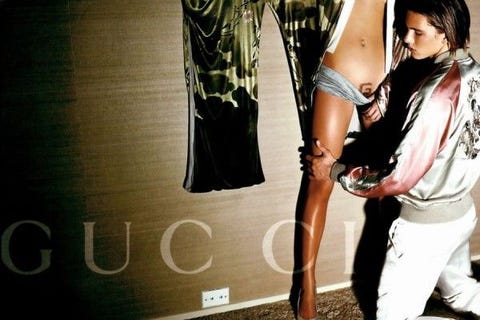In 1995, he cast a fully clothed Amber Valletta to front a campaign, outfitting her in a satiny teal blue shirt (immodestly unbuttoned down to her chest, but modest nonetheless), a matching wool coat, and a logo belt. But in the years since, he dialed up the explicit nature of his vision with each passing season. There was the Fall/Winter 1997 ad with Carolyn Murphy and Angela Lindvall embracing one another in matching patent bondage-like dresses, and another with the two models and Gavin Matthews engaging in a ménage à trois.
It came to a head in 2003 when the luxury brand unveiled its most controversial campaign to date: A provocative spread shot by Mario Testino, styled by Carine, and directed by Doug Lloyd, featuring model Carmen Kass with pulled-down briefs that exposed her pubic hair neatly shaped into Gucci's G logo. "He understood more than anyone else that sex sells," Fern Mallis once said about Ford.

The public response was swift. The Advertising Standards Authority, the U.K.-based self-regulatory organization of the advertising industry, received countless complaints. Consumers deemed it "deeply offensive" and "extremely harmful," and campaigned to ban it. And John Beyer, director of Mediawatch UK, was quoted saying that it was damaging to society: "Imagery showing young women in this way is extremely harmful to society and should not be appearing in mainstream magazines."
But the industry recognized how inventive it was. "Advertising campaigns became more exciting than editorial," Testino previously said. "When I started doing Gucci with Tom Ford he pushed me to new heights." And if the intention was to harness the power of campaigns, to grab attention, to disrupt the status quo, and to spark conversation (even a controversial one), then it worked.
But the industry recognized how inventive it was. "Advertising campaigns became more exciting than editorial," Testino previously said. "When I started doing Gucci with Tom Ford he pushed me to new heights." And if the intention was to harness the power of campaigns, to grab attention, to disrupt the status quo, and to spark conversation (even a controversial one), then it worked.

No comments:
Post a Comment